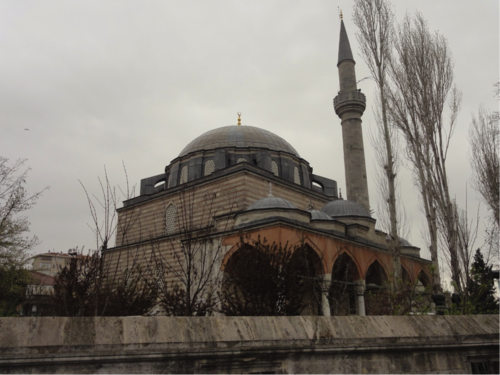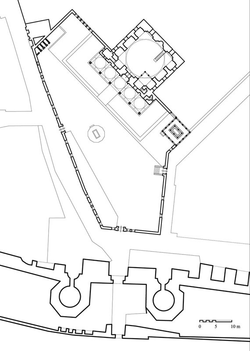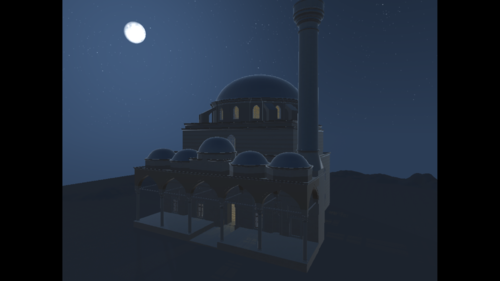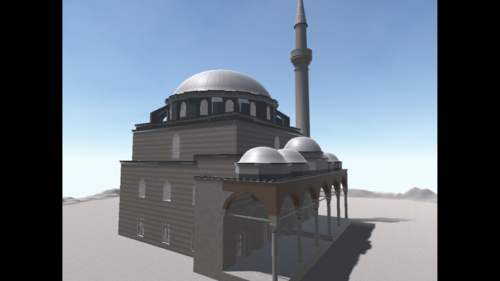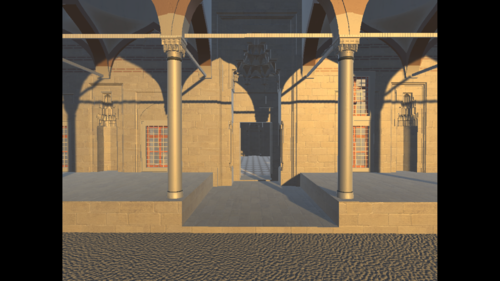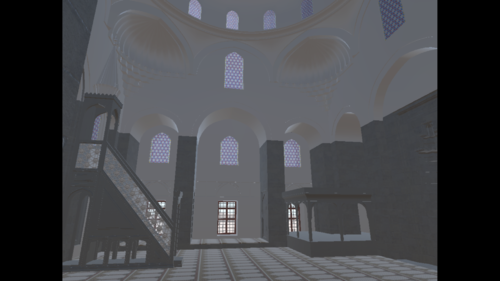Virtual Sonic Architecture
Virtual Sonic Architecture: The Ottoman mosque of Hadım İbrahim Paşa
short link: http://bit.ly/vsahipm
Michael Frishkopf (concept, direction)
Nick Shostak (audio, Unity programming)
Gerry Ricard (3D digital art)
Sahar Kubba (architectural sketches)
Nina Ergin (research)
Text by Michael Frishkopf (michaelf@ulberta.ca, frishkopf.org)
This project was supported by a Social Sciences and Humanities Research Council Grant, “Music, Ritual, and Architecture in Islam” (Michael Frishkopf, Federico Spinetti, Nina Ergin, Irene Markoff).
VSA is a project of the Canadian Centre for Ethnomusicology
Architecture as Light and Sound
John Blacking defined music as “humanly-organized sound”; likewise architecture can be defined as humanly-organized space.
But “music” is also architectural, propagating through humanly-organized space... just as architecture reflects and diffracts humanly-organized sound.
Architecture includes some of the more durable instances of material culture (Notre Dame, the Pyramids of Giza).
We tend to assume that material culture is to be understood as visual culture, but this is not the case. The material reflects and diffracts sound as well as light, and can be perceived through auditory as well as visual senses.
Among the many forms of material culture, architecture is preeminently social, and thus also catalyzes sound through its associated social formations. The sound of architecture is at least as important as the look of architecture.
However the sound– unlike the look–fluctuates rapidly, being tied to society and culture. This is why it is of interest! But its history is typically not recorded.
Q: How can we immersively experience the sound of architecture without traveling in space or even time?
A: Interdisciplinary Research in Sound and Architecture....and Virtual Reality: Virtual Sonic Architecture
The aim of Virtual Sonic Architecture is to enable collective immersive multisensory experience of architectural history, for aesthetic pleasure, intercultural understanding, and educational use. In this particular case, Hadim Ibrahim Pasha mosque, the objective is to experience Ottoman Turkish culture, creating a powerful visual-aural-social experience for a more humanistic appreciation of Islam, its civilization, and its rich history.
The mosque of Hadım İbrahim Paşa (1473-1562)
Hadım Ibrahim Paşa (“Ibrahim Pasha the Eunuch”) was a 16th-century Ottoman statesman from the Ottoman Sanjak (province) of Bosnia. The chief white eunuch and guardian of the imperial palace under Süleyman the Magnificent, he served successively as governor-general of Anatolia, fourth vizier, second vizier, and lieutenant-governor of Istanbul. His eponymous 16th-century mosque, located in the Silivrikapi neighborhood of Istanbul, was constructed by the celebrated Mimar Sinan (1490 – 1588), chief architect (“mimar”) for three Ottoman Sultans: Süleyman, Selim II, and Murad III. Sinan’s buildings dominate Istanbul today, especially the magnificent Süleymaniye Mosque (see Figure 1). Recently renovated, the Hadım İbrahim Paşa mosque (see Figure 2) still stands today, more or less as it was when completed in 1551. Its soundscape however has been radically altered. How can we immersively experience the original mosque, visually and sonically?
Hearing the Built Environment: Virtual Sonic Architecture
Historical Research
How can we hear the original mosque? We draw on research by Associate Professor Nina Ergin (Koç University, Istanbul, and member of our SSHRC team), from her chapter: “A Sound Status among the Ottoman Elite: Architectural Patrons of 16th-Century Istanbul Mosques and Their Recitation Programs,” to appear in Music, Sound, and Architecture in Islam, edited by M. Frishkopf and F. Spinetti (University of Texas Press, in press).
In her research, Professor Ergin demonstrates the particular social importance of soundscape in relation to architecture, as well as clues to its character. The size of an Ottoman mosque, and in particular the number of and arrangement of domes, was thought to index social status. Thus a vizier could not construct a mosque of a size and layout thought to rival a mosque of the royal family.
However sound provided a different way to elevate his status. We learn about Ottoman soundscapes from mosques’ ‘endowment charters’ (vakfiye), which carefully specify which religious texts are to be recited - and when – along with salaries for the reciters thus employed.
Hadım Ibrahim Pasha’s decorous mosque consists of a single 12-meter dome on a cubical base, a relatively modest size conforming to the rank of its patron. Yet, by employing a large number of reciters (55) he was perhaps able to use sound to transcend the status indexed by mosque size.
The following is a list of reciters employed at the mosque of Hadım İbrahim Paşa, with salaries (in akçe, the chief monetary unit of the Ottoman Empire).
- 1 hatip-hafız (reciting with other hafız every day, 5 akçe)
- 5 adult reciters (reciting 10 or more verses before Friday prayer, 2 akçe)
- 5 young reciters (reciting 10 or more verses before Friday prayer, 1 akçe)
- 30 hafız (reciting 1 cüz each for benefit of Prophet, sultan and patron, 2 akçe)
- 1 imam, 4 müezzins, 1 teacher, 1 mekteb student (reciting al-En’am after morning prayer, 3 akçe)
- 6 reciters (reciting Ihlas 500 times after morning prayer, 2 akçe)
- 1 reciter (reciting 10 verses after noon prayer, 1 akçe)
[From Ergin (in press) based on vakfiye document, VGM, Defter no. 574]
Glossary:
- Hatip: Friday preacher
- Hafız: one who has memorized the Qur’an
- Müezzin: one who recites the call to prayer (azzan)
- Imam: prayer leader
- Mekteb: school
- Ihlas, al-En’am: Specific chapters of the Qur’anic
Thus reciters, dedicating their chanting to the patron as well as the dynasty, “constituted a significant element of Ottoman mosque architecture, as much as domes, minarets, decorative tiles and calligraphic inscriptions.” (Ergin, in press)
Architectural history is typically learned, disseminated, and appreciated in books, comprising text and image. But architecture is a spatial art, which cannot be fully understood without the kind of spatial exploration enabled by virtual reality. And the Hadım Ibrahim Paşa mosque is particularly in need of an auditory mode of architectural perception.
Virtual Reality
In our virtual reality multiuser implementation, users experience this soundscape in real time, as mediated by their avatars, auditory and visual environment shifting according to position and time, especially cycles defined by passage of days (including prayers at dawn, noon, afternoon, sunset, and night), weeks (including Sufi ceremonies on Thursday evenings, and Friday congregational prayers at noon), and months (including special events during Ramadan and other Muslim holidays), with corresponding movements of sun and moon, and phases of the latter. The multiuser nature of this game enables it to be repurposed for classroom use at a variety of levels, from middle and high school, to university and beyond, enabling a teacher to enter the space with her or his students, deliver a lecture, answer questions, or organize other activities within the space.
Presently offered as “fish tank VR” with a simple adhan (call to prayer) sounding five times each day, we anticipate significant enhancement as we adapt this Unity-powered game to newer virtual reality headset technologies, and refine algorithms for immersive binaural audio reverb modeling. During the coming year we plan to record Turkish reciters in Istanbul, and use these recordings to provide the mosque with a distinctively Turkish sound.
This exploratory “video game” thus enables immersive, experiential, affective, social learning about architecture, Islam, and Ottoman history, and a new perspective on architectural history, shifted from the remote visual to immersive multisensory domain. Its purpose is both aesthetic – to develop a direct sense of one of the world’s great artistic achievements, carved in space and stone – and educational, from the broad sense of intercultural understanding and an appreciation of architectural history, to specific educational contributions in History, Middle East Studies, Islamic Studies, and Religious Studies.
Some screen shots follow, depicting the mosque model inside and outside, at different times of day. A video will soon be available, and after that the online game itself - stay tuned!
D O W N L O A D...Try Virtual Sonic Architecture!
Please note: this system is still under development. If you try it, please be patient and take notes on its performance for feedback, so we can improve it.
Download here (warning: it's a large zip file (> 1 GB); unzip and run the Mac or Win version, as appropriate). Whoever runs simultaneously should appear together in the system. The first person "in" will be able to control the system clock (which can be set to run faster or slower than real time); others will have to follow. You'll see each others' avatars as colored spheres
Suggestions and notes: Wander into the mosque in the evening to hear various Qur'anic passages being recited, sometimes simultaneously. The adhan emanates from the top of the minaret five times daily. You can fly (there's no gravity); try zooming around the mosque from all sides. The time zone is Edmonton, AB (Mountain Time). Sun and moon follow correct astronomical tables. Weather effects are somewhat random. Note the "green flash" at dawn.
Some known issues:
- The first call to prayer (at noon) is the dawn call ("assalah khayrun min annawm")
- The morning call comes on at sunrise, not fajr
- Sometimes the clock stops
- The reciters are not at present visible (only audible).
Please share your bug reports and feature requests.
References
Reference: “A Sound Status among the Ottoman Elite: Architectural Patrons of 16th-Century Istanbul Mosques and Their Recitation Programs,” to appear in Music, Sound, and Architecture in Islam, edited by M. Frishkopf and F. Spinetti (University of Texas Press, in press).
For more information please contact:

